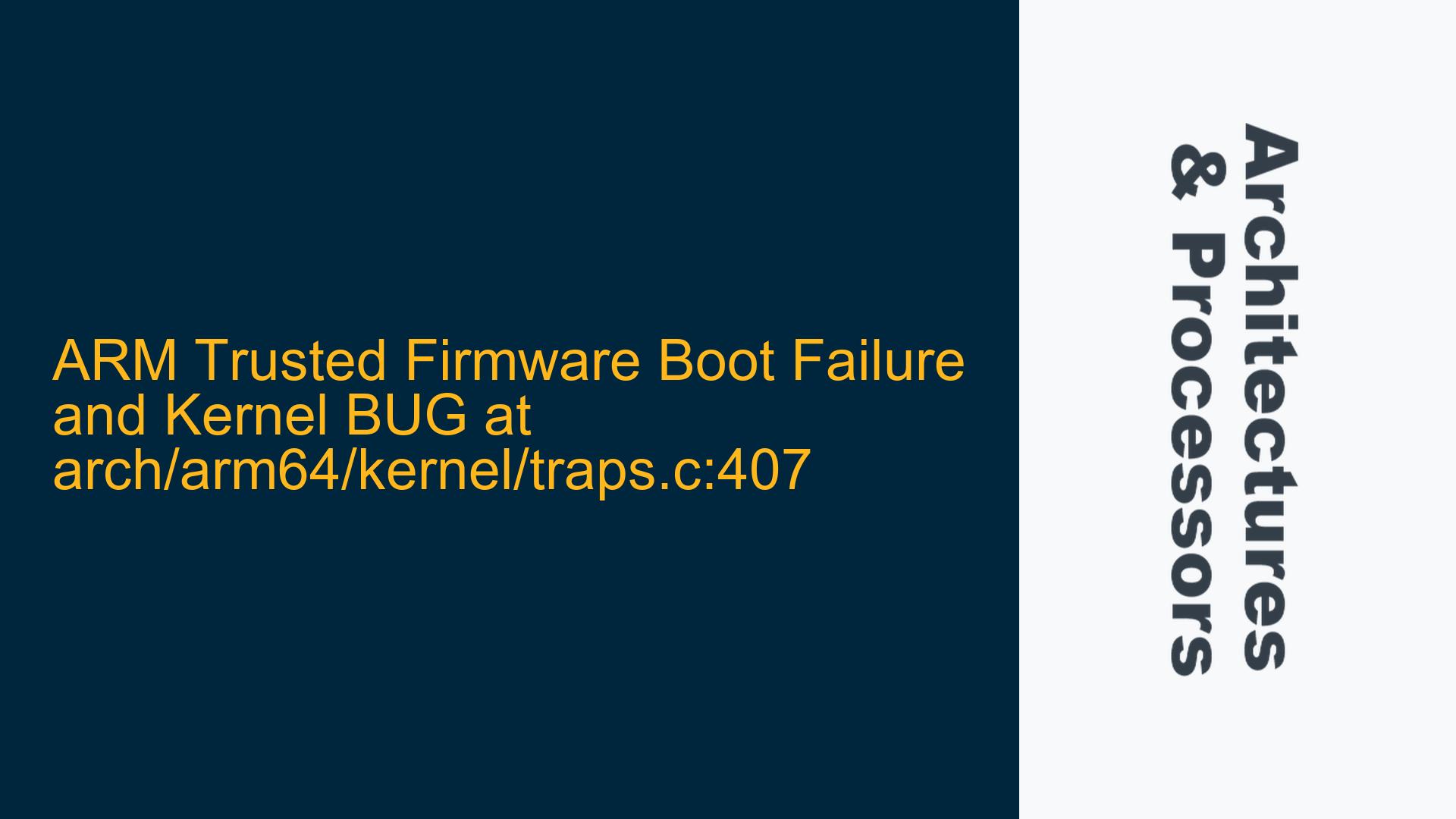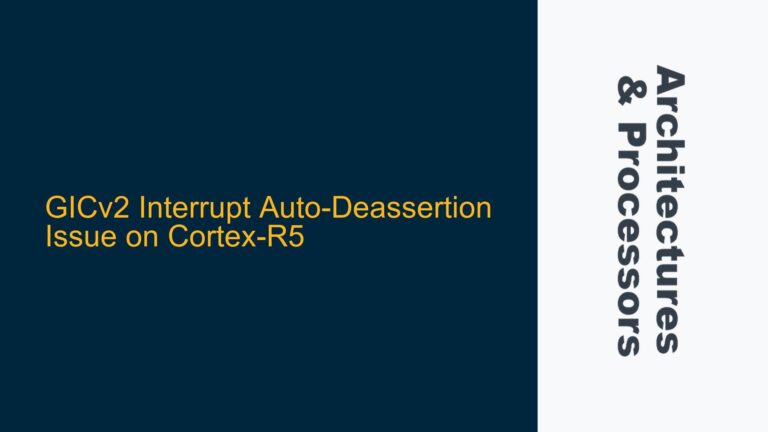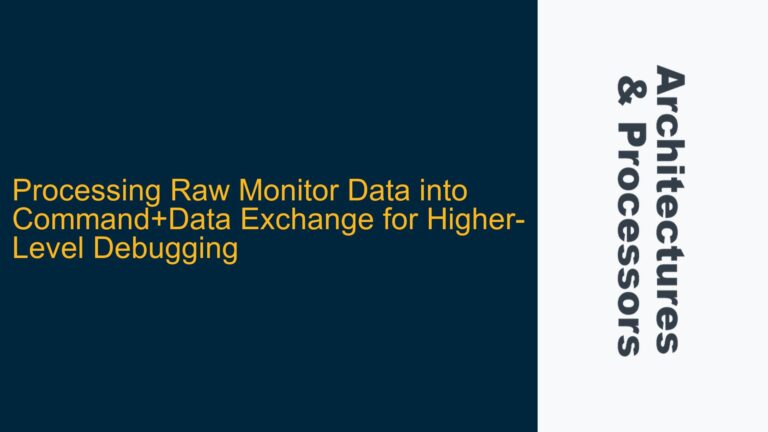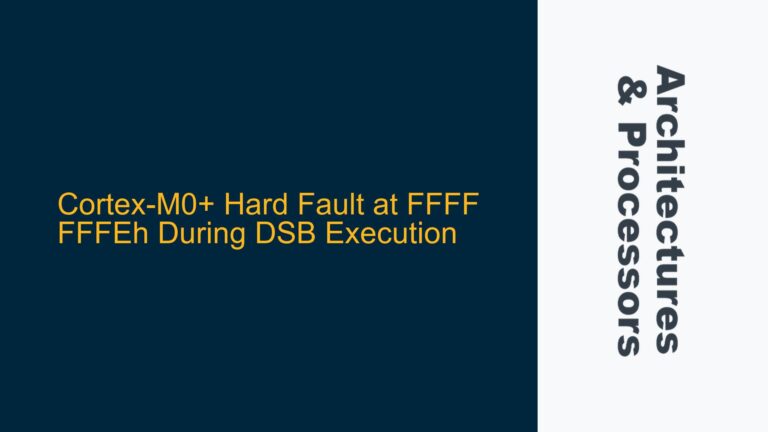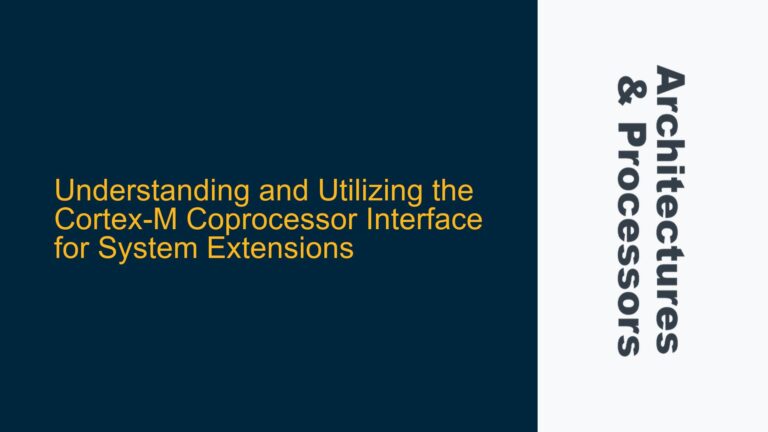ARM Trusted Firmware (ATF) Assertion Failure During Boot Process
The core issue revolves around an assertion failure in the ARM Trusted Firmware (ATF) during the boot process, specifically within the xlat_tables_core.c file. The assertion failure occurs at line 1150, indicating a violation of the ARMv8-A privilege model. The error message suggests that an attempt was made to access a privileged Exception Level (EL) from a non-privileged or less-privileged EL. This is a critical issue as it prevents the system from booting correctly and transitioning to the next stage of the boot process.
The ARM Trusted Firmware is responsible for initializing the system at EL3, the highest privilege level in the ARMv8-A architecture. It sets up the translation tables, configures the memory management unit (MMU), and prepares the system for the transition to lower privilege levels (EL2 or EL1) where the operating system kernel runs. The assertion failure indicates that the firmware encountered an unexpected condition, likely due to a misconfiguration in the translation tables or an incorrect privilege level transition.
The backtrace provided in the error log shows the sequence of function calls leading up to the assertion failure. The functions involved are part of the ARM Trusted Firmware’s translation table management code, which is responsible for setting up the memory mappings required for the system to operate correctly. The failure suggests that the firmware was unable to establish a valid memory mapping, possibly due to an invalid memory region or an incorrect configuration of the translation tables.
Privilege Level Violation and Translation Table Misconfiguration
The primary cause of the assertion failure is a privilege level violation, where an attempt was made to access a privileged EL from a non-privileged or less-privileged EL. This violation is a direct result of a misconfiguration in the translation tables or an incorrect transition between privilege levels. The ARMv8-A architecture enforces strict rules regarding privilege levels, and any violation of these rules results in an exception or assertion failure.
The translation tables in the ARMv8-A architecture define the memory mappings for the system, including the permissions and attributes for each memory region. These tables are crucial for ensuring that the system operates correctly and that each privilege level has access to the appropriate memory regions. A misconfiguration in these tables can lead to a variety of issues, including privilege level violations, memory access errors, and system crashes.
In this case, the assertion failure suggests that the firmware encountered an invalid memory region or an incorrect configuration of the translation tables. This could be due to a variety of factors, including an incorrect memory region definition, an invalid memory attribute, or a bug in the firmware code. The error log indicates that the firmware was unable to establish a valid memory mapping, which prevented the system from transitioning to the next stage of the boot process.
Another possible cause of the issue is an incorrect transition between privilege levels. The ARM Trusted Firmware is responsible for transitioning the system from EL3 to EL2 or EL1, where the operating system kernel runs. If the firmware incorrectly transitions to a lower privilege level or fails to set up the necessary memory mappings, the system may encounter a privilege level violation or an assertion failure.
Debugging and Resolving the ARM Trusted Firmware Assertion Failure
To resolve the ARM Trusted Firmware assertion failure, it is necessary to carefully examine the translation tables and the privilege level transitions during the boot process. The following steps outline the process for debugging and resolving the issue:
-
Review the Translation Tables: The first step in resolving the assertion failure is to review the translation tables used by the ARM Trusted Firmware. These tables define the memory mappings for the system and must be correctly configured to ensure that the system operates correctly. The tables should be checked for any invalid memory regions, incorrect memory attributes, or other misconfigurations that could lead to a privilege level violation.
-
Verify Privilege Level Transitions: The next step is to verify the privilege level transitions during the boot process. The ARM Trusted Firmware is responsible for transitioning the system from EL3 to EL2 or EL1, and any incorrect transition could lead to a privilege level violation. The firmware code should be reviewed to ensure that the transitions are correctly implemented and that the necessary memory mappings are established before transitioning to a lower privilege level.
-
Check for Firmware Bugs: If the translation tables and privilege level transitions appear to be correct, the next step is to check for any bugs in the ARM Trusted Firmware code. The firmware code should be reviewed for any potential issues that could lead to an assertion failure, such as incorrect memory region definitions, invalid memory attributes, or other misconfigurations.
-
Enable Debugging Output: To aid in the debugging process, it may be helpful to enable additional debugging output in the ARM Trusted Firmware. This can provide more detailed information about the state of the system during the boot process and help identify the root cause of the assertion failure. The debugging output should be carefully reviewed to identify any potential issues or misconfigurations.
-
Update the Firmware: If the issue persists, it may be necessary to update the ARM Trusted Firmware to the latest version. The firmware may contain bug fixes or improvements that could resolve the assertion failure. The firmware should be updated to the latest version and the boot process should be retested to determine if the issue has been resolved.
-
Consult the ARM Trusted Firmware Documentation: If the issue remains unresolved, it may be helpful to consult the ARM Trusted Firmware documentation for additional guidance. The documentation provides detailed information about the firmware’s operation, including the translation tables, privilege level transitions, and other critical aspects of the boot process. The documentation should be carefully reviewed to identify any potential issues or misconfigurations.
-
Engage with the ARM Community: If the issue cannot be resolved through the above steps, it may be necessary to engage with the ARM community for additional support. The community can provide valuable insights and assistance in resolving complex issues, and may be able to provide additional guidance or resources to help resolve the assertion failure.
By following these steps, it is possible to identify and resolve the ARM Trusted Firmware assertion failure, allowing the system to boot correctly and transition to the next stage of the boot process. The key to resolving the issue is careful examination of the translation tables, privilege level transitions, and firmware code, as well as leveraging additional debugging output and community support as needed.
Kernel BUG at arch/arm64/kernel/traps.c:407
After resolving the ARM Trusted Firmware assertion failure, the system encounters another critical issue: a kernel BUG at arch/arm64/kernel/traps.c:407. This error occurs during the kernel boot process and indicates that the kernel has encountered an undefined instruction or an unexpected condition that it cannot handle. The error is likely related to the way the kernel is being loaded or initialized, and may be a result of the earlier firmware issue.
The kernel BUG is triggered in the do_undefinstr function, which is responsible for handling undefined instructions in the ARMv8-A architecture. The error log indicates that the kernel encountered an undefined instruction at address 0x41000000, which is the address where the kernel is expected to be loaded. This suggests that the kernel image may be corrupted, or that there is an issue with the way the kernel is being loaded or initialized.
The error log also indicates that the kernel is attempting to execute an instruction that is not recognized by the CPU. This could be due to a variety of factors, including a corrupted kernel image, an incorrect memory mapping, or a bug in the kernel code. The error log provides a backtrace of the function calls leading up to the BUG, which can be used to identify the root cause of the issue.
Corrupted Kernel Image or Incorrect Memory Mapping
The primary cause of the kernel BUG is likely a corrupted kernel image or an incorrect memory mapping. The kernel image may have been corrupted during the boot process, or there may be an issue with the way the kernel is being loaded into memory. The error log indicates that the kernel is attempting to execute an undefined instruction at address 0x41000000, which suggests that the kernel image may not have been correctly loaded or initialized.
Another possible cause of the issue is an incorrect memory mapping. The kernel relies on the memory mappings established by the ARM Trusted Firmware to correctly access memory and execute instructions. If the memory mappings are incorrect or incomplete, the kernel may encounter an undefined instruction or an unexpected condition that it cannot handle. This could be due to a misconfiguration in the translation tables or an issue with the way the kernel is being loaded into memory.
Debugging and Resolving the Kernel BUG
To resolve the kernel BUG, it is necessary to carefully examine the kernel image and the memory mappings used during the boot process. The following steps outline the process for debugging and resolving the issue:
-
Verify the Kernel Image: The first step in resolving the kernel BUG is to verify the integrity of the kernel image. The kernel image should be checked for any corruption or errors that could lead to an undefined instruction. This can be done by comparing the kernel image with a known good image or by using a checksum to verify the integrity of the image.
-
Check the Memory Mappings: The next step is to check the memory mappings used by the kernel. The memory mappings should be reviewed to ensure that they are correctly configured and that the kernel has access to the necessary memory regions. The translation tables should be checked for any invalid memory regions, incorrect memory attributes, or other misconfigurations that could lead to an undefined instruction.
-
Review the Kernel Boot Process: The kernel boot process should be reviewed to ensure that the kernel is being correctly loaded and initialized. The bootloader should be checked to ensure that it is correctly loading the kernel image into memory and that the necessary memory mappings are established before the kernel is executed. The kernel command line should also be reviewed to ensure that it is correctly configured and that any necessary parameters are being passed to the kernel.
-
Enable Kernel Debugging: To aid in the debugging process, it may be helpful to enable additional debugging output in the kernel. This can provide more detailed information about the state of the system during the boot process and help identify the root cause of the kernel BUG. The debugging output should be carefully reviewed to identify any potential issues or misconfigurations.
-
Update the Kernel: If the issue persists, it may be necessary to update the kernel to the latest version. The kernel may contain bug fixes or improvements that could resolve the BUG. The kernel should be updated to the latest version and the boot process should be retested to determine if the issue has been resolved.
-
Consult the Kernel Documentation: If the issue remains unresolved, it may be helpful to consult the kernel documentation for additional guidance. The documentation provides detailed information about the kernel’s operation, including the boot process, memory management, and other critical aspects of the system. The documentation should be carefully reviewed to identify any potential issues or misconfigurations.
-
Engage with the Kernel Community: If the issue cannot be resolved through the above steps, it may be necessary to engage with the kernel community for additional support. The community can provide valuable insights and assistance in resolving complex issues, and may be able to provide additional guidance or resources to help resolve the kernel BUG.
By following these steps, it is possible to identify and resolve the kernel BUG, allowing the system to boot correctly and transition to the next stage of the boot process. The key to resolving the issue is careful examination of the kernel image, memory mappings, and boot process, as well as leveraging additional debugging output and community support as needed.
Conclusion
The issues discussed in this post highlight the complexity of the ARMv8-A boot process and the importance of correctly configuring the ARM Trusted Firmware and kernel. The assertion failure in the ARM Trusted Firmware and the kernel BUG are both critical issues that can prevent the system from booting correctly. However, by carefully examining the translation tables, privilege level transitions, kernel image, and memory mappings, it is possible to identify and resolve these issues.
The key to resolving these issues is a thorough understanding of the ARMv8-A architecture, the ARM Trusted Firmware, and the Linux kernel. By leveraging debugging tools, documentation, and community support, it is possible to diagnose and resolve even the most complex boot issues. With the right approach, it is possible to ensure that the system boots correctly and operates reliably, providing a solid foundation for further development and deployment.
